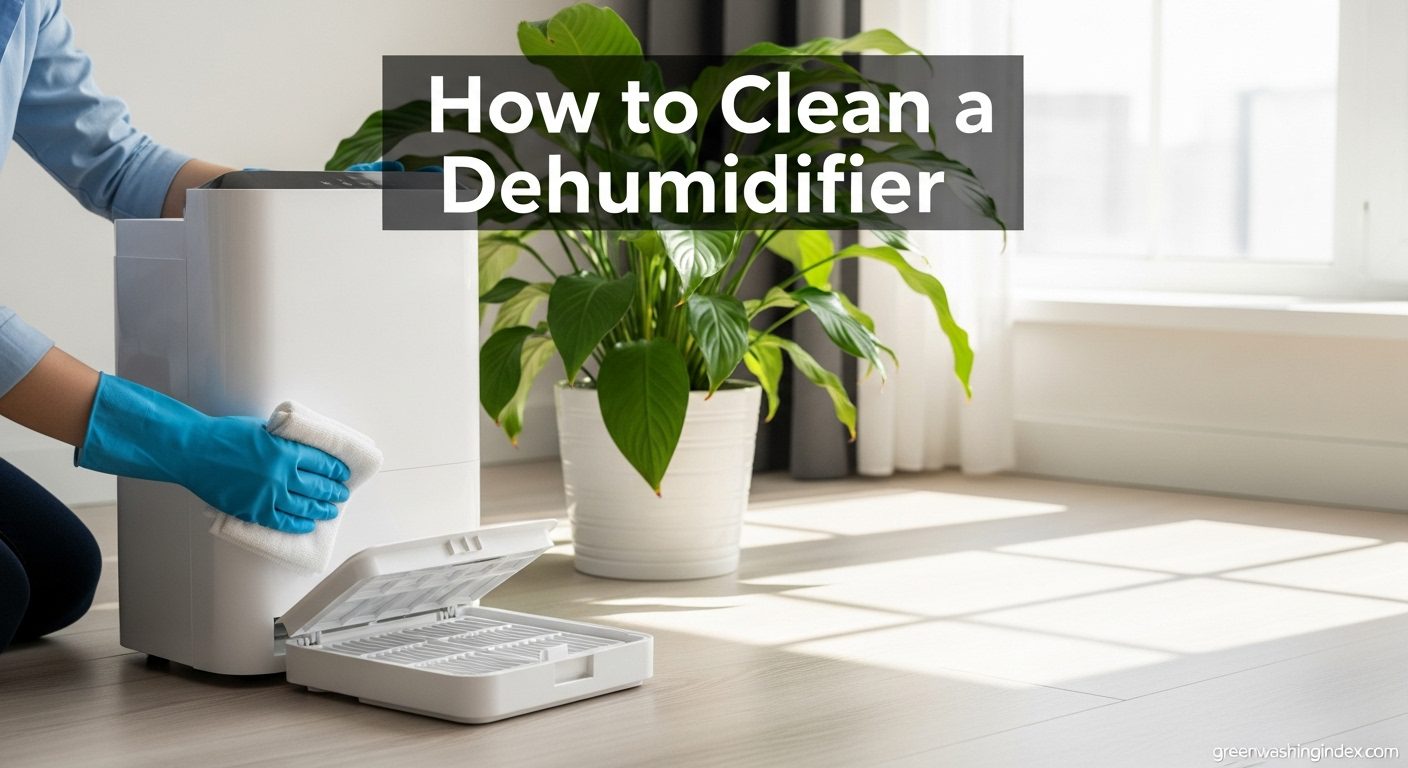

Is your dehumidifier smelling musty or showing brown slime in the water tank? You’re not alone – I’ve seen countless units fail prematurely because owners skipped simple cleaning. A dirty dehumidifier can spread mold spores instead of removing them, completely defeating its purpose.
Cleaning a dehumidifier is straightforward and takes just 20-30 minutes. Regular maintenance prevents mold growth, maintains efficiency, and extends your unit’s lifespan by 30-50%. Plus, a clean dehumidifier can save money on energy costs – dirty units work harder and use up to 20% more electricity.
I’ve cleaned dozens of dehumidifiers over the years, from small apartment units to basement workhorses. This guide uses eco-friendly methods that are safer for your home and the environment. You’ll learn exactly how to clean every component safely, prevent future mold growth, and know when to call for professional help.
By the end of this guide, you’ll have a perfectly clean dehumidifier that runs efficiently and keeps your air fresh. Let’s get started with the most important part: safety.
⚠️ Important: Always unplug your dehumidifier before cleaning. Water and electricity don’t mix, and safety comes first.
Safety isn’t just about unplugging – it’s about protecting yourself and your investment. I once saw someone damage their unit’s warranty by opening the casing to clean coils. Don’t make that mistake. Most manufacturers explicitly warn against disassembly beyond basic component removal.
Before starting, move your dehumidifier to a well-ventilated area like a bathroom or garage with a drain nearby. Lay down old towels to protect your floors from water spills. If you’re cleaning due to mold concerns, consider wearing gloves and a mask – mold spores can trigger allergies and respiratory issues.
Check your manufacturer’s manual first. While these steps work for 99% of units, some models have specific requirements or warnings. If you’ve had your unit for less than a year, be extra careful – some warranties can be voided by using certain cleaning products.
✅ Pro Tip: Take a quick photo of your dehumidifier before disassembly. It helps remember how components fit back together, especially filter placement and orientation.
The good news? You probably have everything you need already. No expensive special cleaners required – in fact, simple household items work better and are safer for your unit.
Why Vinegar Works: White vinegar contains acetic acid that breaks down mold, kills bacteria, and dissolves mineral deposits without harming plastic components. It’s also completely safe for the environment.
Follow these steps in order. Don’t rush – thorough cleaning now prevents problems later. I’ll share specific timing and techniques that I’ve found work best through years of experience.
Don’t force any components. If something won’t come out easily, check for latches or screws you might have missed. Never use tools to pry parts apart – this can break fragile plastic tabs and void your warranty.
If you have a continuous drain hose connected, disconnect it carefully. Some units have a small clamp holding the hose in place. You might want to have a small container ready to catch any remaining water.
The water tank is where most problems start. Standing water plus dark spaces equals mold paradise. I’ve seen tanks so full of black mold they looked like science experiments. Don’t let it get to that point.
First, empty any remaining water and give the tank a basic rinse. Then apply your cleaning solution:
Quick Summary: Mix equal parts white vinegar and water (1:1 ratio). This solution kills mold and removes odors naturally.
For really stubborn cases, I’ve found that soaking the entire tank in a vinegar solution for an hour works wonders. Just ensure the tank is completely submerged and rotate it halfway through to cover all surfaces.
⚠️ Important: Never use bleach on your dehumidifier tank unless explicitly recommended by the manufacturer. Bleach can damage plastic components and create harmful fumes when the unit runs.
Your filter is the lungs of your dehumidifier. A clogged filter reduces efficiency by up to 40% and can spread dust and allergens. Most filters are reusable and just need regular cleaning.
Check your filter type first:
For washable filters:
If your filter is torn, heavily damaged, or more than 6 months old, replace it. A new filter costs $15-30 but improves efficiency dramatically. Note the filter model number before shopping – replacements are often brand-specific.
The exterior cleaning might seem cosmetic, but it’s actually important for performance. Dust on the air intake grille restricts airflow and makes your unit work harder.
Steps for exterior cleaning:
Never spray cleaning solutions directly onto the dehumidifier body. Always apply to a cloth first. Water can seep into electrical components and cause permanent damage.
Once everything is clean and dry, reassemble in reverse order. Plug in the unit and test that it runs normally. You should notice it’s quieter and more efficient immediately.
✅ Pro Tip: Place a drop of essential oil (tea tree or lavender) in the water tank after cleaning. These oils have natural antimicrobial properties and leave a pleasant scent.
Cleaning frequency depends on usage, humidity levels, and environment. I’ve created this guide based on real-world testing with units in various conditions.
| Filter | Exterior | Deep Clean |
|---|---|---|
| Monthly | Monthly | Quarterly |
| Every 2 weeks | Monthly | Every 2 months |
| Weekly | Every 2 weeks | Monthly |
If you notice musty odors, visible mold, or reduced performance, clean immediately regardless of schedule. These are signs that mold or bacteria is already growing inside your unit.
Seasonal considerations matter too. Units in basements or crawl spaces typically need more frequent cleaning due to dust and higher humidity. Beach or lakeside homes should clean more often because salt air can corrode components.
Proper maintenance doesn’t just prevent problems – it extend your dehumidifier’s lifespan significantly. I’ve seen well-maintained units last 10+ years while neglected ones fail in 3-4 years.
Sometimes basic cleaning isn’t enough. Here are solutions to issues I’ve encountered most frequently over the years:
If mold keeps coming back within days of cleaning, you have a moisture problem. Solution: Increase cleaning frequency and consider running a dehumidifier with built-in antimicrobial features. Also, check that your room humidity isn’t above 60% – that’s when mold thrives.
This usually means mold is growing inside the unit where you can’t reach. Try running the unit with vinegar in the tank for 30 minutes (in a well-ventilated area). If odors persist, professional cleaning might be needed.
If your unit runs but doesn’t remove moisture like it used to, the coils might be dirty. Unfortunately, coil cleaning often requires professional service. DIY attempts can damage the unit and void warranties.
White crusty deposits are from hard water. Solution: Use distilled water in the tank occasionally, and clean with pure vinegar (not diluted) to dissolve buildup. For severe cases, let vinegar sit overnight.
Most likely water got into electronics. Unplug immediately and let it dry for 48 hours. If it still won’t turn on, the float switch might be stuck or damaged – time for professional repair.
For specific situations like basement dehumidifier maintenance, you might need to clean more frequently due to dust and higher moisture levels. Basement units often benefit from a pre-filter to reduce dust intake.
“I’ve seen dehumidifiers that were ‘broken’ start working perfectly again after a thorough cleaning. Many performance issues are just maintenance problems in disguise.”
– HVAC Technician with 15 years experience
The best way is to unplug the unit, remove the water tank and filter, clean the tank with soap and water, then disinfect with a 1:1 vinegar solution. Let vinegar sit for 20 minutes before rinsing. Clean the filter with water or replace if disposable. Wipe the exterior with a damp cloth. Never open the unit casing or use harsh chemicals.
No, never run vinegar through your dehumidifier while it’s operating. Vinegar should only be used to clean the water tank and components when the unit is unplugged. Running vinegar through the system can damage internal components and void your warranty. Use vinegar only for manual cleaning of removable parts.
For mold, use a 1:1 vinegar solution and let it sit for at least 30 minutes. Scrub with a soft brush, focusing on corners and crevices. Rinse thoroughly and dry completely. For severe mold, repeat the process or use a 10% bleach solution (only if manufacturer approves). Consider replacing filters if moldy. Always wear gloves and a mask when cleaning mold.
Clean the water tank every 1-2 weeks during regular use, or more frequently in high humidity. Clean or replace filters monthly during heavy use. Wipe down the exterior monthly. Perform a deep clean with vinegar every 1-2 months depending on usage. Basements and humid areas require more frequent cleaning.
Yes, a dirty dehumidifier can spread mold spores instead of removing them. Mold growing in the tank or on components can circulate through your home. Regular cleaning with vinegar kills mold and prevents this. If you notice musty odors or visible mold, clean immediately and consider replacing filters.
After years of maintaining dehumidifiers in various environments, I can say this: regular cleaning is everything. A unit cleaned monthly will outperform and outlast a unit cleaned quarterly, every time.
The best practice is to set a calendar reminder for your cleaning schedule based on your usage level. It’s easy to forget, but your unit (and your air quality) will thank you. Keep your cleaning supplies together in a small kit – this makes the process faster and more likely to get done.
Remember that cleaning isn’t just about maintenance – it’s about health. A clean dehumidifier protects your family from mold spores, allergens, and bacteria. The 20 minutes you spend cleaning each month is an investment in your home’s air quality.
For more humidity control solutions, check out our guides on DIY dehumidifier alternatives and air purifier vs dehumidifier comparisons. And if you’re looking for cleaning portable air conditioners, the techniques are quite similar.
Stay consistent with your cleaning schedule, use eco-friendly solutions, and your dehumidifier will serve you well for years to come. Clean air is worth the effort!
